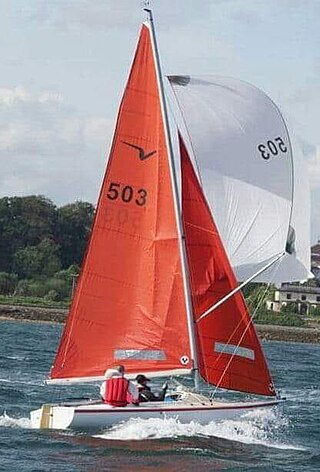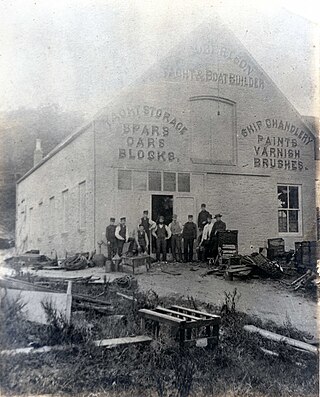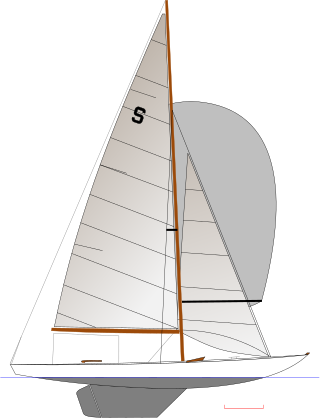
The Firth of Clyde is the mouth of the River Clyde. It is located on the west coast of Scotland and constitutes the deepest coastal waters in the British Isles. The firth is sheltered from the Atlantic Ocean by the Kintyre peninsula, which encloses the outer firth in Argyll and Ayrshire. The Kilbrannan Sound is a large arm of the Firth of Clyde, separating the Kintyre Peninsula from the Isle of Arran. Within the Firth of Clyde is another major island – the Isle of Bute. Given its strategic location at the entrance to the middle and upper Clyde, Bute played a vital naval military role during World War II.

Caledonian MacBrayne, usually shortened to CalMac, is the major operator of passenger and vehicle ferries, and ferry services, between the mainland of Scotland and 22 of the major islands on Scotland's west coast. Since 2006, the company's official name has been CalMac Ferries Ltd, although it still operates as Caledonian MacBrayne. In 2006, it became a subsidiary of holding company David MacBrayne, which is owned by the Scottish Government.

The Holy Loch is a sea loch, a part of the Cowal peninsula coast of the Firth of Clyde, in Argyll and Bute, Scotland.

Loch Long is a body of water in the council area of Argyll and Bute, Scotland. The Sea Loch extends from the Firth of Clyde at its southwestern end. It measures approximately 20 miles in length, with a width of between one and two miles. The loch also has an arm, Loch Goil, on its western side.

A Squib is a type of small racing keelboat designed in 1967 by Oliver Lee as a successor to the Ajax 23. It is a strict "one-design" class of boat, having a length of 19', beam of 6'1½", a sail area of 170 sq. ft. upwind, 310 sq. ft. total and a weight of 1500 lb (680 kg). The usual crew is two people and the boat can be cruised or raced with a Portsmouth Yardstick of 1142. The Squib has been adopted by the RYA as the National Keelboat and is big enough to race at sea and small enough to be trailed easily behind a family car.

An iceboat is a recreational or competition sailing craft supported on metal runners for traveling over ice. One of the runners is steerable. Originally, such craft were boats with a support structure, riding on the runners and steered with a rear blade, as with a conventional rudder. As iceboats evolved, the structure became a frame with a seat or cockpit for the iceboat sailor, resting on runners. Steering was shifted to the front.

MV The Second Snark is a small passenger ferry, built in 1938 by William Denny of Dumbarton, later operated by Clyde Marine Services on the Firth of Clyde, Scotland.

The Dragon is a one-design keelboat designed by Norwegian Johan Anker in 1929. In 1948 the Dragon became an Olympic Class, a status it retained until the Munich Olympics in 1972. The Dragon's long keel and elegant metre-boat lines remain unchanged, but today Dragons are constructed using the latest technology to make the boat durable and easy to maintain. GRP construction was introduced in 1973 and the rigging has been regularly updated.
Sail Canada is Canada's governing body for the sport of sailing. Sail Canada is a "Member National Authority" of World Sailing. Organization of sailing in Canada is divided into four groups: yacht clubs, Provincial Sailing Associations, class associations, and Sail Canada itself.

The RS Feva is a two-person sailing dinghy designed by Paul Handley in 2002. It is manufactured and distributed by RS Sailing. The RS Feva is an International Sailing Federation (ISAF) International Class, a Royal Yachting Association (RYA) Supported Junior Class, and has been selected by the Dansk Sejlunion and Norges Seilforbund for major sailing growth projects.

The Seabird Half Rater is the oldest one design class still sailing in Britain. It is a 20 ft carvel planked sailing boat, with a design dating back to 1898. As of the 2017 season there have been 101 built [up to No.108]. The class has a Portsmouth Yardstick of 1229.

A sailing yacht, is a leisure craft that uses sails as its primary means of propulsion. A yacht may be a sail or power vessel used for pleasure, cruising, or racing. There is no standard definition, so the term applies here to sailing vessels that have a cabin with amenities that accommodate overnight use. To be termed a "yacht", as opposed to a "boat", such a vessel is likely to be at least 33 feet (10 m) in length and have been judged to have good aesthetic qualities. Sailboats that do not accommodate overnight use or are smaller than 30 feet (9.1 m) are not universally called yachts. Sailing yachts in excess of 130 feet (40 m) are generally considered to be superyachts.

Clyde Muirshiel Regional Park is the collective name for areas of countryside set aside for conservation and recreation on the South Clyde estuary in Scotland.
The Fish class sloop, also known informally as the Fish Boat, is a one-design sailboat designed in 1919 by New Orleans resident Rathbone DeBuys, member of the Southern Yacht Club. It is reputed to have been the most popular sailboat racing class on the US Gulf Coast in the early 20th century and was the Gulf Yachting Association one-design racer until it was replaced by the Flying Scot in 1969.

MV Jupiter was a passenger and vehicle ferry in the fleet of Caledonian MacBrayne in the Firth of Clyde, Scotland. She was the oldest of three "streakers" and the third River Clyde ship to bear the name 'Jupiter'. Her open car deck was accessible by stern and side ramps ro-ro. She entered service in 1974, and operated the Gourock to Dunoon crossing for much of her career. In 2006, she became the oldest vessel in the CalMac fleet and continued in service with them until 2010. Jupiter was sold for breaking in 2011.

Alexander Robertson & Sons was a boatyard in Sandbank, Argyll and Bute, Scotland, from 1876 to 1980. The yard was located on the shore of the Holy Loch, not far from the Royal Clyde Yacht Club (RCYC) at Hunters Quay, in the building that is now the Royal Marine Hotel, which was the epicentre of early Clyde yachting. Alexander Robertson started repairing boats in a small workshop at Sandbank in 1876, and went on to become one of the foremost wooden boatbuilders on Scotland's River Clyde. The "golden years" of Robertson's yard were in the early 1900s, when it started building some of the first IYRU 12mR & 15mR racing yachts. Robertson's was well known for the quality of its workmanship and was chosen to build the first 15-metre yacht designed by William Fife III. More than 55 boats were built by Robertson's in preparation for the First World War and the yard remained busy even during the Great Depression in the 1930s as many wealthy businessmen developed a passion for yacht racing on the Clyde. During World War II the yard was devoted to Admiralty work, producing a wide range of large high-speed Fairmile Marine Motor Boats. After the war, the yard built the successful one-class Loch Longs and two 12-metre challengers for the America's Cup: Sceptre (1958) and Sovereign (1964). Due to difficult business conditions, the Robertson family sold the yard in 1965, and it was turned over to glass-reinforced plastic production work until it closed in 1980. During its 104-year history, Robertson's Yard built 482 numbered boats, many of which are still sailing today.

The Swallow is a type of one-design classic keelboat that was used as a two-man Olympic class for the 1948 Olympics. It is now sailed with three crew. Now a thoroughly modern classic, the main fleet is at Itchenor in Chichester Harbour, West Sussex, with a smaller fleet at Aldeburgh, Suffolk. There are around 40 active boats. As a National Class, the rules and affairs of the Class are regulated by the Royal Yachting Association. Many of these boats are named after birds and, in particular, sea birds.

MV Arran was a pioneering Firth of Clyde vehicle ferry introduced by Caledonian Steam Packet Company in 1953. She spent fifteen years on the Upper Clyde crossings, followed by five years at Islay. Initially hoist-loading, via side ramps, these were replaced by a stern ramp in 1973. During her final years with CalMac, she relieved across the network. Several unsuccessful attempts were made to turn her into a floating restaurant, before she was scrapped in 1993.
The RS Eliteclass is a 24-foot keelboat class designed by Phil Morrison. Built to meet the requirements of the Hayling Island Sailing Club, the class has a start at Cowes Week and events around the United Kingdom. Fleets can be found at the Royal Burnham Yacht Club in the UK, as well as at Falmouth, Belfast Lough, Cowes, Hayling Island and Lymington. Outside the UK, the class can be found in locations such as the Caribbean, Guernsey, Holland, Norway and Sweden.
The Water Wag is the oldest one-design dinghy in existence, having been devised in 1886 and formalised as a one-design class in Ireland in 1887. It was last modified in 1900. The class is still sailed to this day, notably with large Water Wag fleets racing during summer evenings from Dún Laoghaire harbour on Dublin Bay. The Water Wag class is administered by the Water Wags club, based in Dún Laoghaire.

















